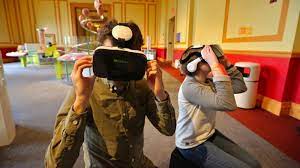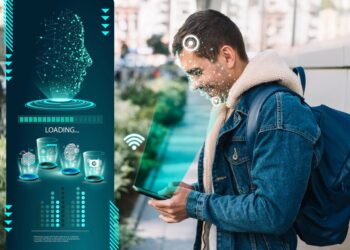Virtual Reality for Museums: Enhancing Visitor Experience
Museums have been around for centuries, providing visitors with an opportunity to learn about history, art, science, and culture. However, with the rise of new technologies, museums are now exploring new ways to engage visitors and enhance their experience. One of the most promising technologies is virtual reality (VR), which allows visitors to explore exhibits in a more immersive and interactive way. In this article, we will explore the ways in which VR is transforming museums and enhancing visitor experience.
Virtual Reality Exhibits
One of the most exciting applications of VR in museums is the creation of virtual reality exhibits. These exhibits allow visitors to explore a virtual environment, providing a more immersive and engaging experience.
For example, a museum exhibit on ancient Egypt could include a VR experience that allows visitors to explore the pyramids and tombs in 3D, providing a more realistic and interactive experience. Similarly, a museum exhibit on marine life could include a VR experience that allows visitors to swim with dolphins and explore the coral reef.
VR exhibits can provide visitors with a deeper understanding and appreciation of the subject matter, as well as create a more memorable and engaging experience. They can also attract new audiences, including younger visitors who are accustomed to digital technologies.
Virtual Reality Tours
Another promising application of VR in museums is the creation of virtual reality tours. These tours allow visitors to explore a museum or gallery from the comfort of their own home, providing a more accessible and convenient experience.
For example, a museum could create a virtual reality tour that allows visitors to explore the exhibits and galleries, providing a more immersive and engaging experience than a traditional online tour. This can help to attract visitors who are unable to visit the museum in person, as well as provide a new revenue stream for the museum.
Virtual Reality Learning
VR can also be used to enhance the learning experience in museums. By using VR, museums can create interactive and immersive experiences that help visitors to learn about a subject in a more engaging and memorable way.
For example, a museum exhibit on the human body could include a VR experience that allows visitors to explore the different systems of the body, providing a more interactive and engaging learning experience. Similarly, a museum exhibit on astronomy could include a VR experience that allows visitors to explore the solar system and learn about the planets.

VR learning experiences can help visitors to retain information better, as well as provide a more engaging and enjoyable learning experience. They can also attract new audiences, including younger visitors who are accustomed to digital technologies.
Challenges of VR in Museums
While VR offers many benefits for museums, there are also challenges that need to be addressed. One of the biggest challenges is the cost of implementing VR technology. The initial investment required for VR exhibits and tours can be high, and museums need to carefully evaluate the potential return on investment.
Another challenge is the need for specialized skills and training to create VR experiences. Museums need to ensure that their staff are trained on how to create and maintain VR exhibits and tours, as well as how to provide support to visitors who are using VR technology.
Finally, museums need to ensure that VR experiences are relevant and engaging for visitors. VR experiences that are too gimmicky or irrelevant may turn off visitors and have a negative impact on the museum’s brand.
Overall, the use of VR in museums offers many benefits, providing new ways to engage visitors and enhance their experience. By creating VR exhibits, tours, and learning experiences, museums can provide visitors with a more immersive and interactive experience, as well as attract new audiences.
However, museums must also address the challenges of cost, skills, and relevance to ensure that VR experiences are used effectively and provide value to visitors. As the technology continues to evolve, we can expect to see even more innovative applications of VR in museums, helping to create a more engaging and memorable experience for visitors.
Furthermore, the use of VR in museums can also help to improve accessibility for visitors with disabilities. VR exhibits and tours can be designed to be accessible for a wide range of users, including those with visual impairments or physical disabilities. This can help to create a more inclusive and diverse museum experience, improving the satisfaction and loyalty of visitors.
In addition, the use of VR in museums can also help to create a more sustainable and environmentally-friendly experience. VR tours and exhibits can reduce the need for visitors to travel to the museum, reducing the carbon footprint of the museum and promoting sustainable tourism.
Finally, the use of VR in museums can also help to create a more interactive and social experience for visitors. VR experiences can be designed to be shared with friends and family, providing a more social and engaging experience. This can help to increase the likelihood of repeat visits and word-of-mouth recommendations.

In conclusion,
The use of VR in museums offers many benefits, providing new ways to engage visitors and enhance their experience. By creating VR exhibits, tours, and learning experiences, museums can provide visitors with a more immersive and interactive experience, as well as attract new audiences. As the technology continues to evolve, we can expect to see even more innovative applications of VR in museums, helping to create a more engaging and memorable experience for visitors while promoting accessibility, sustainability, and social interaction.
Moreover, the use of VR in museums can also help to preserve and protect valuable artifacts and exhibits. VR technology can be used to create digital copies of exhibits and artifacts, allowing museums to protect them from damage or deterioration. This can also help to make exhibits more accessible to visitors, as they can be viewed in a digital format without the need for physical access.
VR can also be used to create simulations of historical events or places, providing visitors with a more accurate and immersive experience. For example, a museum exhibit on the Roman Empire could include a VR experience that allows visitors to explore a virtual version of the Colosseum, providing a more realistic and engaging experience. This can help to create a deeper understanding and appreciation of history, as well as make it more accessible to a wider audience.
Finally, the use of VR in museums can also help to create new revenue streams for museums. By offering VR tours and experiences, museums can attract new audiences and generate additional revenue. VR experiences can also be sold as merchandise or souvenirs, creating a new revenue stream for the museum.







